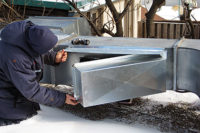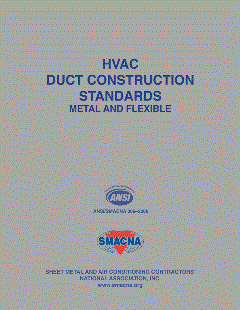For those HVAC contractors who offer duct-cleaning services, it can be a valuable part of their operations that not only helps their customers but also opens the door to more business. But, when it’s done improperly or unnecessarily, it can do more harm than good. That’s why those in the duct-cleaning industry are urging contractors to commit to proper training and ensure they’re looking at the bigger picture before adding these important services to their businesses.
A VALUABLE SERVICE
In addition to aggravating allergies, spreading dust, and causing unpleasant odors, dirty ductwork can also negatively affect system performance, said Rick MacDonald, president at Armstrong Duct, Vent & Chimney in Manchester, New Hampshire, and a member of the National Air Duct Cleaners Association (NADCA) Board of Directors. “Dust, dirt, and other particulate will restrict air movement across cooling coils and fans, which can increase energy costs,” he explained. “Removing particulates like dust and dirt from the air-handling system will cut down on dusting, cut energy costs, and contribute to better IAQ.”
As awareness of the many benefits of clean air ducts spreads, the opportunity to perform duct-cleaning services will also grow, said David Ford, president of Baltimore-based Ductz Intl., a system of 63 franchisees specializing in duct cleaning across the country. “IAQ is becoming a much more prevalent issue these days, especially with people who have allergies or any breathing issues, and the indoor environment is becoming much more top-of-mind.”
With more and more contractors adding duct-cleaning services to their businesses, NADCA is ensuring they have the training and resources available to properly perform these services, MacDonald said. NADCA’s Standard for the Assessment, Cleaning, and Restoration of HVAC Systems, or the ACR Standard, provides air-duct cleaners with practical and reliable industry-backed information for assessing new and existing HVAC systems, evaluating and verifying cleanliness to a specific level of cleanliness, and preventing job hazards.
“If adding to an already established business, I would advise [contractors] have a person dedicated to being in charge of this part of their operation and mentoring the technicians providing the service,” MacDonald said. “Join NADCA and attend NADCA training in person and online.”
Bob Elledge, president and CEO of Rotobrush Intl. LLC, a manufacturer of duct-cleaning equipment and products, also stressed the importance of proper and thorough training for contractors looking to perform duct-cleaning services. “We have a three-step process with [our] video, and you can come [to us], as well — we have 24/7 tech support.”
But, providing high-quality duct-cleaning services doesn’t stop with cleaning.
“If you’re going to clean ducts, you want to make sure they’re sealed, too,” Elledge said. “And, most importantly, the homeowner needs to have the proper filtration in their units, and you need to make sure to change out that filtration or clean it. Homeowners with sealed ducts, filtration, and clean ducts shouldn’t have to have their ducts cleaned for a while. And, considering air is blown throughout the house, as a contractor, that’s what you should aim to do — clean, seal, and filter the system.”
INSPECTION FIRST
The most important thing technicians and contractors can do is ensure they’re only cleaning ductwork that truly needs it. That begins with a thorough inspection of the duct system — something that not all duct-cleaning companies do, Ford said.
“Contractors should perform a full assessment first and look into the air handler to see if there’s microbial growth or particulates. We also recommend removing some registers and taking pictures. We provide a lot of before-and-after pictures to our clients, since it’s kind of an intangible service.”
It is worth noting, Ford added, that not all customers who believe they need their ductwork cleaned actually do.
“We do a full assessment, and we have a lot of franchisees to this day that tell people they don’t need it,” Ford said. “We’ll walk away from a job if they don’t need it.”
Clint Orr, owner of Full Throttle, a duct-cleaning company in Regina, Saskatchewan, Canada, also said contractors should always inspect the ductwork first.
“Before cleaning takes place, technicians should inspect the ductwork in detail,” said Orr, who uses the ANATROLLER ARI-100 from Robotics Design Inc. to clean and inspect ductwork. “Our robots can provide a live feed or recorded video of the level of contamination. If the technician sees dust, debris, or other contaminants, he or she should recommend cleaning, and if there are pets, smokers, or occupants with respiratory illnesses or allergies in the home, brushing and disinfecting the duct will be necessary, since even low levels of dust could contain harmful contaminants.”
MISTAKES TO AVOID
In addition to urging contractors to use NADCA’s ACR Standard to properly clean the entire duct system, MacDonald also urged them to be wary of cross contamination.
“Proper zoning is essential to a successful project,” he said. “Additionally, today’s modern residential HVAC systems have a significant amount of wiring in the blower compartment. Caution must be taken when cleaning this area.”
Ford said he often sees contractors make two mistakes when cleaning ductwork.
“Many people aren’t using the proper equipment. The way we clean is with a negative air machine, which is a vacuum. The system should be under negative pressure the entire time, so all the particulate you’re kicking up and moving through agitation tools is being pulled down to that HEPA vacuum. Some guys don’t use a consistent negative pressure, so you’re not losing all the contaminants. And the other is that they’re not cleaning the entire system.”
Another mistake contractors make regarding duct services concerns their marketing tactics and delivering sub-par services.
“You don’t want to be the bait-and-switch guy,” Ford warned. “Really, as an HVAC contractor, you don’t want to do that, especially with Twitter, Facebook, and all the places where people can talk about your business online. You don’t want to be that guy doing those low $59 ads and not delivering a quality product.”
TOOLS OF THE TRADE
Before adding duct-cleaning services, contractors need to be sure they have all the right tools to do the job right.
“At a minimum, an air-duct cleaner will need a power vacuum collection device capable of collecting the debris removed and to prevent cross contamination during cleaning, an air compressor, a variety of air tools for agitation and moving of particulate to the vacuum, a variety of remote reaching brushes for agitation, a smaller HEPA vacuum for contact vacuuming, hand tools, and an assortment of sheet metal tools,” MacDonald said. “A golfer carries many clubs in his or her bag to achieve the results needed to play the game successfully. An air-duct cleaner will also need an assortment of equipment to be successful in this industry. There is no one piece of equipment that does it all.”
To start, Ford also said contractors “need a HEPA vacuum that can hook up to the system — not a shop vac, but a negative air machine. What you need are agitation tools — brushes mechanically driven by cordless drills and air tools, such as a high-volume air compressor.”
Rotobrush recently introduced the BrushBeast for residential and commercial contractors looking to improve their duct-cleaning services. It features a 90 percent increase in vacuum power, increased maneuverability, and improved durability.
“A lot of our contractors were telling us they needed power, and that’s how the BrushBeast came into existence,” Elledge said. “They wanted more power, so we gave them more power.”
The new ANATROLLER robot line is also designed to improve the duct-cleaning process for contractors.
“The ANATROLLER robots make it easy for duct cleaners to conform to NADCA cleaning guidelines perfectly while cleaning faster than with any product on the market,” said Cherif Noumair, president of Flexnet Ventilation in Blainville, Quebec, Canada. “While a dust collector attached to the duct work creates negative pressure in the duct, the robot brushes the dust, which is collected by the dust collector, and, after all the dust has been removed, the robot sprays disinfectant or sealant.”
THE BOTTOM LINE
Adding duct-cleaning services can bring in valuable new business and boost a contractor’s bottom line, but before a contractor enters the market, he or she needs to understand and commit to the time and costs involved in properly training and equipping their teams.
“If you’re going to be serious about it, don’t just do it as an add-on to add money to your revenue,” Ford said. “You have to do it for your customers, to provide better IAQ. If you’re not serious, you’ll spend $5,000 or $6,000 on equipment, and it won’t be worth it. You need to be serious and focused on it, and be in it for the right reasons.”
Elledge agreed, adding that contractors shouldn’t underestimate what duct cleaning brings to a business.
“It provides leads into a lot of other things outside of just duct cleaning,” he said. “You can start putting your company’s labels on the HVAC systems so that if they break down, they call you. It gives you a pathway into the house, and it creates leads for you. You shouldn’t look at it as just duct cleaning.”
Publication date: 9/21/2015
Want more HVAC industry news and information? Join The NEWS on Facebook, Twitter, and LinkedIn today!












